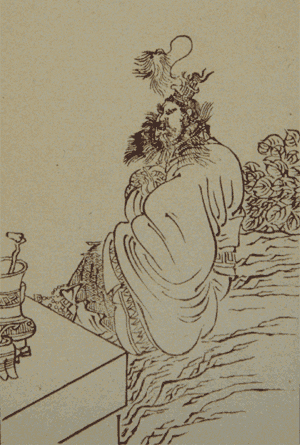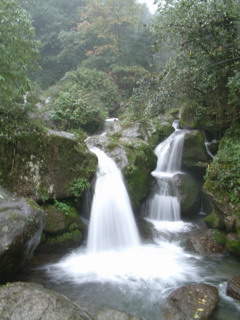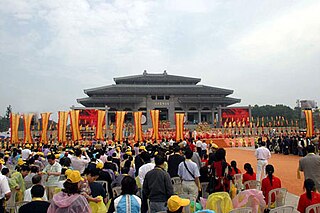
The Tao Te Ching is a Chinese classic text and foundational work of Taoism written around 400 BC and traditionally credited to the sage Laozi, though the text's authorship, date of composition and date of compilation are debated. The oldest excavated portion dates back to the late 4th century BC, but modern scholarship dates other parts of the text as having been written—or at least compiled—later than the earliest portions of the Zhuangzi.

Taoism or Daoism is a diverse tradition indigenous to China, variously characterized as both a philosophy and a religion. Taoism emphasizes living in harmony with what is known as the Tao—generally understood as being the impersonal, enigmatic process of transformation ultimately underlying reality. The Tao is represented in Chinese by the character 道, which has several related meanings; possible English translations for it include 'way', 'road', and 'technique'. Symbols such as the bagua and taijitu are often employed to illustrate various aspects of the Tao, which can never be sufficiently described with words and metaphors alone. Taoist thought has informed the development of various practices and rituals within the Taoist tradition and beyond, including forms of meditation, astrology, qigong, feng shui, and internal alchemy. A common goal of Taoist practice is self-cultivation resulting in a deeper appreciation of the Tao, and thus a more harmonious existence.

The Tao is the natural way of the universe, whose character one's intuition must discern to realize the potential for individual wisdom, as conceived in the context of East Asian philosophy, religion, and related traditions. This seeing of life cannot be grasped as a concept. Rather, it is seen through actual living experience of one's everyday being. Its name, "Tao", or "Dao" , came from Chinese, where it signifies the way, path, route, road, or sometimes more loosely doctrine, principle, or holistic belief.

Laozi, also romanized as Lao Tzu and various other ways, was a semi-legendary ancient Chinese philosopher, author of the Tao Te Ching, the foundational text of Taoism along with the Zhuangzi. Laozi is a Chinese honorific, typically translated as "the Old Master". Modern scholarship generally regards his biographical details as invented, and his opus a collaboration. Traditional accounts say he was born as Li Er in the state of Chu in the 6th century BC during China's Spring and Autumn Period, served as the royal archivist for the Zhou court at Wangcheng, met and impressed Confucius on one occasion, and composed the Tao Te Ching in a single session before retiring into the western wilderness.

The Three Pure Ones, also translated as the Three Pure Pellucid Ones, the Three Pristine Ones, the Three Divine Teachers, the Three Clarities, or the Three Purities, are the three highest gods in the Taoist pantheon. They are regarded as pure manifestations of the Tao and the origin of all sentient beings, along with the "lords of the Three Life Principles or 'Breaths' (qi)". They were also gods who were "associated with the sky, the earth and the underworld."

Mantak Chia is a Taoist Master. Mantak Chia is the creator of the Healing Tao, Tao Yoga, Universal Healing Tao System, and Tao Garden Health Spa & Resort, located in the northern countryside of Chiang Mai, Thailand. He wrote more than 60 books on Taoist practices and taught the principles of Taoist internal arts. His books have been translated into more than 40 languages. He views himself primarily as a teacher.

Zhang Ling, courtesy name Fuhan, was a Chinese religious leader who lived during the Eastern Han dynasty credited with founding the Way of the Celestial Masters sect of Taoism, which is also known as the Way of the Five Pecks of Rice, and he is credited as being the founder of Taoism in legend.

Mount Qingcheng is a sacred Taoist mountain in Dujiangyan, Chengdu, Sichuan, China.
The Three Treasures or Three Jewels are basic virtues in Taoism. Although the Tao Te Ching originally used sanbao to mean "compassion", "frugality", and "humility", the term was later used to translate the Three Jewels in Chinese Buddhism, and to mean the Three Treasures in Traditional Chinese Medicine.
The Three Treasures or Three Jewels are theoretical cornerstones in traditional Chinese medicine and practices such as neidan, qigong, and tai chi. They are also known as jing, qi, and shen.
The Huahujing is a Taoist work, traditionally attributed to Laozi.

In the study of comparative religion, the East Asian religions or Taoic religions, form a subset of the Eastern religions. This group includes Chinese religion overall, which further includes Ancestral Worship, Chinese folk religion, Confucianism, Taoism and popular salvationist organisations, as well as elements drawn from Mahayana Buddhism that form the core of Chinese and East Asian Buddhism at large. The group also includes Japanese Shinto, Tenrikyo, and Korean Muism, all of which combine Shamanistic elements and indigenous ancestral worship with various influences from Chinese religions. Chinese salvationist religions have influenced the rise of Japanese new religions such Tenriism and Korean Jeungsanism; as these new religious movements draw upon indigenous traditions but are heavily influenced by Chinese philosophy and theology.
The history ofTaoism stretches throughout Chinese history. Originating in prehistoric China, it has exerted a powerful influence over Chinese culture throughout the ages. Taoism evolved in response to changing times, with its doctrine and associated practices being revised and refined. The acceptance of Taoism by the ruling class has waxed and waned, alternately enjoying periods of favor and rejection. Most recently, Taoism has emerged from a period of suppression and is undergoing a revival in China.
The Wuzhen pian is a 1075 Taoist classic on Neidan-style internal alchemy. Its author Zhang Boduan was a Song dynasty scholar of the Three teachings.
The Qingjing Jing is an anonymous Tang Dynasty Taoist classic that combines philosophical themes from the Tao Te Ching with the logical presentation of Buddhist texts and a literary form reminiscent of the Heart Sutra. It instructs students of the Tao to practice the elimination of desire in order to cultivate spiritual purity and stillness.

The Xishengjing is a late 5th century CE Taoist text with provenance at the Louguan 樓觀 "Tiered Abbey" of The Northern Celestial Masters. According to Daoist tradition, Louguan was near where the legendary Laozi 老子 transmitted the Tao Te Ching to the Guardian of the Pass Yin Xi 尹喜. The Xishengjing allegedly records the Taoist principles that Laozi taught Yin Xi before he departed west to India.

Taoist meditation, also spelled Daoist, refers to the traditional meditative practices associated with the Chinese philosophy and religion of Taoism, including concentration, mindfulness, contemplation, and visualization. The earliest Chinese references to meditation date from the Warring States period.
The following outline is provided as an overview of and topical guide to Taoism:
Heshang Gong is the reputed author of one of the earliest commentaries on the Tao Te Ching of Laozi to survive to modern times, which is dated to the latter part of the Han dynasty. He was reputedly a reclusive Chinese hermit from the 1st century CE.
Taoist philosophy also known as Taology refers to the various philosophical currents of Taoism, a tradition of Chinese origin which emphasizes living in harmony with the Dào. The Dào is a mysterious and deep principle that is the source, pattern and substance of the entire universe.











